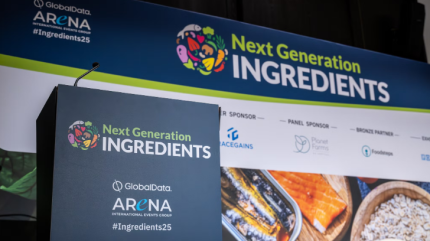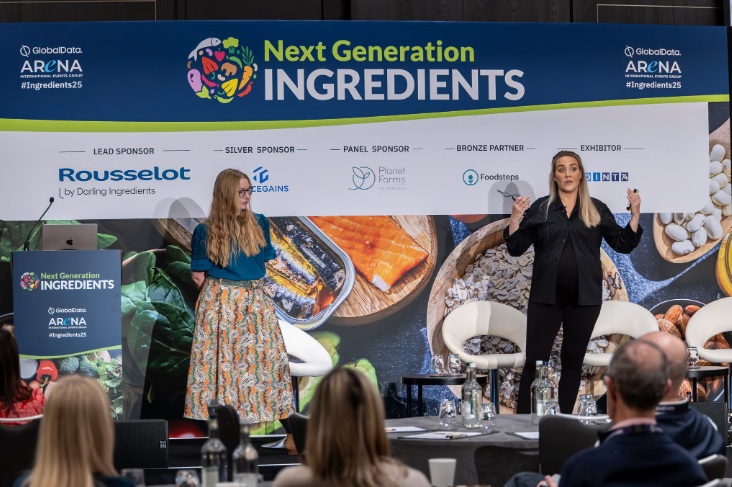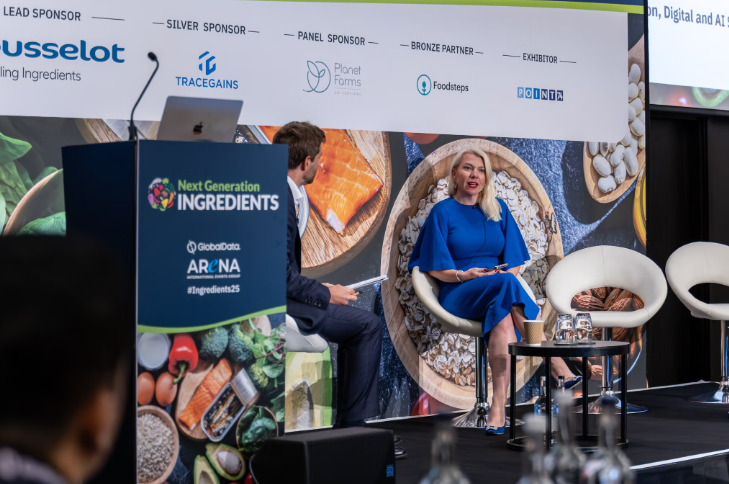
From rising consumer interest in gut health and the increasing use of GLP-1 drugs, to ethical sourcing and AI-driven reformulation, the two-day Next Generation Ingredients 2025 conference, held in London earlier this month, highlighted how food manufacturers and their ingredient suppliers are trying to respond to a changing marketplace.
Gut health entering mainstream
Gut health dominated the conversation at Next Generation Ingredients 2025, reflecting how quickly the topic has moved from niche science into the mainstream, with fibre, protein, prebiotic and microbiome-friendly ingredients becoming more important factors in buying habits.

Discover B2B Marketing That Performs
Combine business intelligence and editorial excellence to reach engaged professionals across 36 leading media platforms.
“Previously, gut health has only been about digestion but, in the last 20 years, it’s become more about bacteria and the microbiome,” Caitlin Hall, head of research at UK-based gut-health supplements firm Myota Health, told the event.
Despite the growing interest in gut health, it’s important to remember there is still a long way to go in educating consumers. According to Hall, only 15% of respondents to a recent Myota Health survey were aware of the term prebiotics. She emphasised the importance of simplifying the messages put out to consumers, using a zoo as a metaphor to better explain the microbiome and its dietary needs.
“Your microbiome is like a zoo,” she said. “If you’ve got lions, tigers and zebras, they all consume a different diet. Instead of adding more animals to the system, you should focus on feeding the existing animals in your zoo with different types of diets and fibres.”
Focused on gut-friendly snacks, drinks and high-fibre products, The Gut Stuff is looking to become a major player in the UK gut-health category (and beyond) by breaking down the science behind the microbiome.

US Tariffs are shifting - will you react or anticipate?
Don’t let policy changes catch you off guard. Stay proactive with real-time data and expert analysis.
By GlobalDataNow stocked in UK grocers including Tesco and The Co-op, The Gut Stuff seeks to champion making gut-health products more affordable and accessible.
At the event, The Gut Stuff co-founder Lisa MacFarlane underlined her company’s goal: to take gut health out of cereal and dairy. “For us, our mission was always to be front of store for consumers,” she said. “We wanted to drive incrementality in stores for younger shoppers interested in gut health at the time.”
Rebecca Oliver-Mooney, director of commercial at UK grocer The Co-op, appeared on a panel with MacFarlane and she emphasised the role economics can play in consumers’ choices.
“Statistically, there are often more fast-food outlets in areas of low socio-economic backgrounds, which means that accessibility and affordability of those can sometimes be a choice that people will make,” she said.

The impact of GLP-1
The ripple effect of GLP-1 medications on consumers’ eating habits was, unsurprisingly, a major talking point at the event.
An Maris, business development manager of health and nutrition at ingredients supplier Rousselot, discussed the growing use of the medications in Europe.
She said: “It’s no secret that consumers are looking for ways to improve their health. The GLP-1 trend has arrived in the UK and Europe and it will start increasing at a really high speed.
“Looking at the per cent of households where there is more than one member of the family using GLP-1 medication, you see a tremendous increase of 78% over the past year. That is now more than 4% of UK households.”
GLP-1 drugs, associated with appetite suppression, were first approved to treat Type-2 diabetes in the US more than 15 years ago and for the treatment of obesity around a decade ago.
However, with more consumers turning to the medication to manage their weight, its impact on purchasing behaviour is growing. Some industry watchers believe GLP-1 use will have a “structural” impact on the market.
Food manufacturers as well as their ingredient suppliers are now having to respond. Maris pointed to companies like Nestlé targeting GLP-1 users with nutrient-dense, high-protein products that induce the GLP-1 hormone naturally in the body.
“Natural GLP-1-inducing ingredients will be important in helping people to come off the medication,” Maris said, noting the ingredients are designed to help consumers “maintain a healthy metabolic balance in terms of their blood glucose management”. She added Rousselot’s research showed its collagen peptides could induce the GLP-1 hormone, reducing post-meal glucose spikes by 42%.
Maris added: “Once that is done, this will help them in optimising their energy and will also help to avoid these cravings.”
The length of time consumers are on GLP-1 drugs varies, with most often seeing results within six to 12 months. Maris believes that, as consumers come off the drugs, food producers can benefit by developing more nutrient- and protein-rich snacks to assist them in that process.
“All of this together will support consumers in maintaining a sustainable, healthy, weight-management journey,” Maris said.

The role of AI in innovation
Another big subject at the conference was AI, technology which is increasingly being used across the supply chain, including in product development and innovation.
Ines Ashton, digital and AI strategy director at UK-based convenience manufacturer The Compleat Food Group, highlighted AI’s potential in innovation, emphasising its ability to predict consumer trends.
“AI enables us to listen at scale. For us to see and understand trends, we need to see how and why consumers are buying certain products,” she said.
AI should be used as a co-pilot to our chefs to make sure they’re looking six months ahead, rather than six months behind.
Ines Ashton, The Compleat Food Group
Ashton sought to underline how AI should complement the innovation strategies of Compleat’s in-house product development teams, saying “AI will not replace chefs and the palatability of products” as “models don’t have taste buds.”
She added: “AI should be used as a co-pilot to our chefs to make sure they’re looking six months ahead, rather than six months behind. I have found that most of the chefs are very eager to engage with AI to discuss what it can bring.”
Ashton also discussed how different parts of the workforce might view AI. “As younger generations enter the marketplace, I think there’s less and less resistance,” she said. “There is a generational gap that needs to be bridged and I do think the pushback is coming more from the older generations.
“However, what does resonate with older generations is profitability. If you can change your perception and realise that AI can speed up your route to market, it can increase your probability of success by giving you clear indications of where you should play. I think that is how you can overcome some of the pushbacks.”
Compleat, Ashton said, uses ChatGPT, Obsidian and Copilot, deploying the tools “across the internet, to listen and track what is happening”.
She added: “We ask these models to listen to particular websites that are of interest like Mumsnet or Reddit. We can listen at scale. No desktop research can be as good and as powerful as AI.”
“It’s a big enabler to listen at scale, in order for us to hear trends, and in order for us to understand not only what people are consuming, but also why they’re consuming.
“The more we can understand the occasions and the rationale behind why people are consuming a product, the more likely we can develop new products that resonate with our consumers.”

Ethical sourcing and supply chains as standard
Further up the supply chain, a panel at the conference focused on sustainable sourcing, a topic that’s emerging as a baseline expectation of brands among a growing number of consumers. The panellists emphasised how shoppers assume manufacturers are taking responsibility for the people and ecosystems behind their ingredients.
In a panel discussion on sustainable sourcing, Bryan Towell, procurement director at AB World Foods underscored how issues such as farmer livelihoods, and land-use transparency have moved firmly into the mainstream, driven by younger shoppers who want proof of impact rather than broad sustainability claims.
“Younger consumers are increasingly making their purchasing decisions, and the brands they support, around ethics and trust,” Towell said.
“If you are found to not to have done your due diligence and those consumers find something that doesn’t actually reflect what your brand stands for, then you’ve got a problem.”

Nonetheless, Towell said that there is a misconception among some consumers about farming supply chains in emerging markets like Asia.
“People have a very Western view of farming, with massive machinery and huge fields. In Asia it’s just not like that,” he said “There’s a lot of farmers who are operating below the poverty line in India. They are on around 80 rupees per person, per day.
“We identified a local NGO, and we set up a programme called the Spice Project, which is our support programme in India. We’re working with 5,000 farmers in two main villages. It’s about how we can support livelihoods in those countries. Ethical issues are usually founded in lack of money, so we’re trying to solve that.”
The panel also discussed certification and a need for on-the-ground verification to was emphasised.
Jason Archie-Acheampong, sustainable sourcing lead at The Fairtrade Foundation, said: “From a Fairtrade lens, part of the beauty of our global model is that we have a whole range of producer networks which are locally-led.
“If you go to Kenya, that’s being led by Fairtrade Africa. If you go over to a country in Asia, that is similarly being led by a local producer network there. That means that we have boots-on-the-ground and people regularly working alongside our farmers to understand the daily risks that are arising.”





